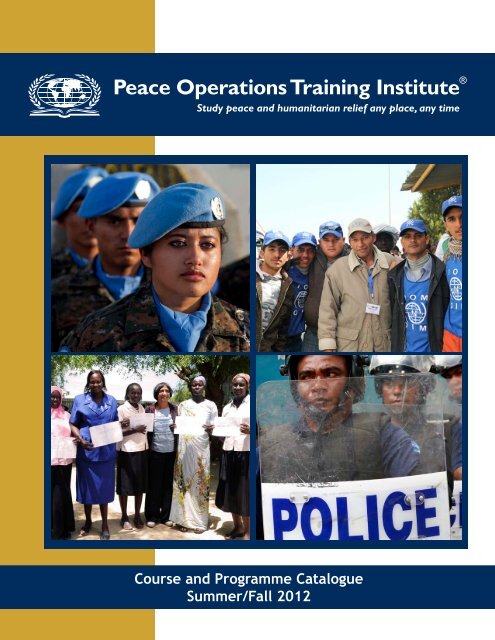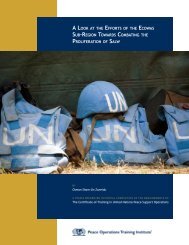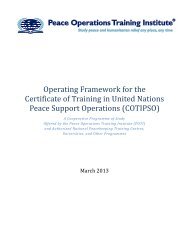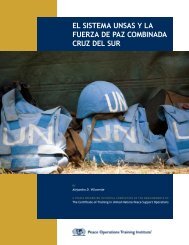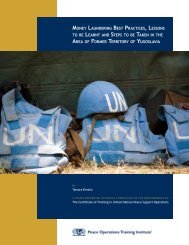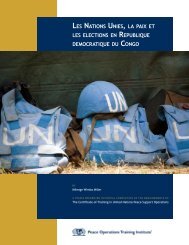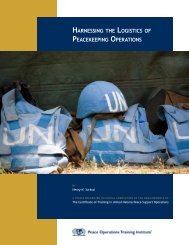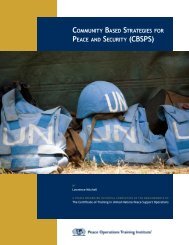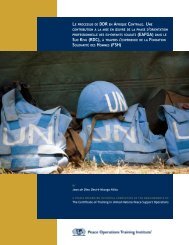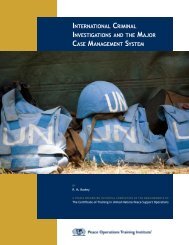Download - Peace Operations Training Institute
Download - Peace Operations Training Institute
Download - Peace Operations Training Institute
You also want an ePaper? Increase the reach of your titles
YUMPU automatically turns print PDFs into web optimized ePapers that Google loves.
INSTITUTIONAL ENROLMENT PROGRAMMESIntegrated Distance Learning Programme (IDLP)Many UN Missions subscribe to the IDLP, providing openenrolment to mission personnel. To see if your missionparticipates, contact your Mission <strong>Training</strong> Focal Point(TFP).Special Programmes for all Personnel Serving onUN, AU, or EU MissionsAll personnel serving on UN missions, includingInternational and National Staff, Military Observers,UN Police, UNVs, members of formed military units,and others are eligible for reduced-rate programmesdesigned specifically for them.Distance Learning Programme for Nations (DLPN)Under the DLPN, POTI and national trainingprogrammes jointly provide POTI’s peacekeepingtraining courses to their military personnel at no cost. Astudent’s Certificate of Completion shows both nationaland <strong>Peace</strong> <strong>Operations</strong> <strong>Training</strong> <strong>Institute</strong> certification. Tosee if your nation participates, contact your ministry ofdefence.E-Learning for African <strong>Peace</strong>keepers (ELAP) and<strong>Peace</strong>keepers from Latin America and the Caribbean(elPlaC)All military personnel, police, and gendarmerie whoare citizens of African nations or the nations of LatinAmerica and the Caribbean may enrol at no cost throughthe sponsored regional scholarships ELAP or ELPLAC.In 2012, these regional scholarships are made possiblethrough the generous support of Australia, Canada, theNetherlands, Norway, Sweden, and the United Kingdom.Other Bulk Enrolment ProgrammesPOTI offers additional opportunities for bulk-enrolmentprogrammes whereby institutions may integrate POTIcourses into their own training programmes. To see ifyour institution is eligible for one of these programmes,write to help@peaceopstraining.org.Distance Learning Programme for Organizations(dlPO)A number of NGOs, IGOs, PVOs, and otherorganizations involved in peacekeeping have elected totrain their employees through <strong>Peace</strong> <strong>Operations</strong> <strong>Training</strong><strong>Institute</strong> courses. Employees of these organizations mayenrol at no cost to them. Ask your organization whetherthey subscribe to this enrolment option. Individual NGO,IGO, or PVO personnel worldwide who are associatedwith an organization that does not subscribe to DLPOmay still be elligible.UN Photo #480091 by Victoria HazouProgrammes for Colleges and Model UNParticipantsAll university and college students, faculty, staff, andModel UN participants may enrol at a reduced tuitionrate. This programme also gives universities worldwidethe opportunity to offer our courses as supplementalreading or primary text material for undergraduate andgraduate curricula, allowing interested scholars andModel UN participants the chance to study real-worldtraining used by peacekeepers and mission staff.UN Photo #465228 by Marco DorminoCours en FrançaisLa majorité de nos cours sont disponibles en français.Pour consulter la liste de nos cours traduits, veuillezconsulter notre site internet à l’adresse http://www.peaceopstraining.org/fr/.Cursos en EspañolLa mayoría de nuestros cursos están disponibles enespañol. Para la lista de traducciones actualizadas ydisponibles, por favor visite nuestro sitio web en http://www.peaceopstraining.org/es/.3
The CurriculumUN Photo #138198 by Eric KanalsteinAn Introduction to the United NationsSystem: Orientation for Serving on a FieldMission (Revised 6/2011)[In English, French, Spanish, Portuguese, and Arabic]An Introduction to the UN System: Orientation forServing on a UN Field Mission is an introductory coursedesigned for students who may have limited knowledgeof the United Nations. The course itself consists of fourmain sections. The first two are intended to give thestudent a thorough awareness of the guiding principlesof the UN at the institutional and operational level. Thefollowing two sections focus on the practicalities and theproblems that a Field Operator may encounter, as wellas the means to deal with such issues.This course should provide the student with an adequatebase of the following topics: the purpose and principlesof the United Nations, its system, and its institutionalframework; the United Nations’ roles in the areasof peace, security, and development; applicationsof international humanitarian law and human rights;application of communication, negotiation, and mediationtechniques; issues regarding safety and security; andgeneral obligations and responsibilities of the FieldOperator. The objectives of the course are based onthe policies and principles of the United Nations, as wellas similar objectives as expressed by organizations/institutes and nongovernmental organizations. Newto this edition is the compilation and developmentof information that focuses entirely on the civiliansassigned to United Nations field missions. Nine lessons,220 pages.COURSE AUTHOR: LTC Christian Hårleman, Armyof Sweden, Retired and former Chief of <strong>Training</strong>, UNDepartment <strong>Peace</strong>keeping <strong>Operations</strong>. Served on UNMissions in Latin America, Africa, Asia, Europe, MiddleEast.Principles and Guidelines for UN<strong>Peace</strong>keeping <strong>Operations</strong>[In English] Free Tuition for AllThis course has been developed in consultation withthe <strong>Peace</strong>keeping Best Practices Section of the UNDepartment of <strong>Peace</strong>keeping <strong>Operations</strong>’ Policy,Evaluation and <strong>Training</strong> Division. It is based on theinternal DPKO/DFS publication entitled United Nations<strong>Peace</strong>keeping <strong>Operations</strong>: Principles and Guidelines,which is more widely known under its informal nameCapstone Doctrine. This publication is a comprehensivedocument that defines and promulgates availablepeacekeeping doctrine, definitions, procedures, andpolicy. In ten chapters, it introduces the conceptand evolution of UN <strong>Peace</strong>keeping, explains thedecision process that precedes the deployment of apeacekeeping operation, and then the planning processto implement that decision. It also discusses the art ofsuccessful mandate implementation and addressesthe management of peacekeeping operations, howoperations are supported and sustained, and how theyare concluded at their termination. The <strong>Institute</strong> coursePrinciples and Guidelines is designed to teach thisDPKO doctrine to all UN personnel serving in the fieldand at Headquarters, as well as to those who are new toUN peacekeeping. Ten chapters, 208 pages.Commanding United Nations <strong>Peace</strong>keeping<strong>Operations</strong> (Revised 6/2011)[In English, French, Spanish, and Portuguese]This course was designed for military, police, and civilianstudents who may find themselves in leadership positionsin peacekeeping operations, or for those wishing tounderstand the responsibilities and difficulties that comewith commanding a peacekeeping operation. It is usefulfor participants at the strategic, operational, and tacticallevels, and for senior and junior leaders on peacekeepingoperations. Topics include UN Organs and Agencies;the Initiation and Definitions of UN <strong>Peace</strong>keeping<strong>Operations</strong>; the UN Department of <strong>Peace</strong>keeping<strong>Operations</strong> and <strong>Peace</strong>keeping Doctrine; the Relationshipand Agreements between the UN and Troop- andPolice-Contributing Countries; <strong>Training</strong> and PreparationResponsibilities; the Selection and Preparation of UNMission Leaders; the Chain of Command; Sustainabilityand Logistical Support Requirements; Memoranda ofUnderstanding; Civil-Military Coordination; MissionComponents and Mission Integration; Cross-Cutting4
Issues such as Human Rights, DDR, Gender, andSafety and Security; the Medical Responsibilities ofCommanders; Tactical Techniques, and much more. Thecourse also faithfully reproduces primary documentssuch as the Model SOFA and Model MOU, an UNMILSoldier’s Pocket Card that contains the Rules ofEngagement, patrol reports, and other support material.Nine lessons, 327 pages.COURSE AUTHOR: Major General Tim Ford, RoyalAustralian Army, Retired, Former Head of Mission,UNTSO, and former Military Adviser to the Secretary-General.Ethics in <strong>Peace</strong>keeping[In English, French, and Spanish]This course provides a basic overview and creates anunderstanding of ethics in peacekeeping. Through the useof case studies and practical examples, this compilationaims to serve as a guideline for peacekeepers in thefield and provides some perspectives concerning themajor aspects of modern-day peacekeeping from anethical point of view. Topics include: the Code of Conduct;Cultural Awareness; Gender and <strong>Peace</strong>keeping; SEA andHuman Trafficking; Child Protection; Human Rights; HIV/AIDS Awareness; and UN Guidelines and Procedures onDiscipline for Uniformed <strong>Peace</strong>keepers. Eight lessons,132 pages.Human Rights and <strong>Peace</strong>keeping (New)[In English]This course examines the cross-cutting principles andobligations concerning human rights within the specificcontext of armed conflicts and United Nations peaceoperations. Human rights is a dimension that transcends allphases and employs all components of a peace operation,leading to often complex implementation planning andcoordination, which this course traces and delineates.The course begins by reviewing the landmark documentsand instruments indispensible to the protection of humanrights in theory, before demonstrating how such protectionis enforced and performed on the ground. It discussesthe various types of human rights violations, identifiesthe groups of people especially at risk, and conducts athorough analysis on the concept of protection. The coursecontains important sections on human rights partners andon the process of accountability, which, as the coursedemonstrates, is essential in peace operations if anestablished peace is to be long-lasting and sustainable. 10Lessons, 284 pages.COURSE AUTHOR: Patrick Marega Castellan is a humanrights consultant who has served in various capacitiesfor United Nations missions in Haiti, Darfur, Angola, andLiberia.Human Rights (New)[In English]This course is a comprehensive historical overview of thetheory and practice of human rights. This course exploresthe different kinds of human rights, the various internationaland regional documents necessary to protect and enforcethem, and the historical difficulties and conflicts that haveoccurred in spite of, and often because of, human rights.It includes extensive discussions on the developmentof the various human rights treaties and enforcementmechanisms, the special protection given to vulnerablegroups, human rights during armed conflict, and currentdebates involving human rights, such as the use oftechnology either to promote or restrict human rights, andthe increasing international significance of stateless actorslike transnational corporations and terrorist groups. Fifteenlessons, 356 pages.COURSE AUTHOR: Jessica C. Lawrence, J.D.UN Photo #489640 by Albert Gonzalez Farran5
Implementation of Security CouncilResolution 1325 (2000) in Africa (New)[In English]Security Council resolution 1325 (2000), unanimouslyadopted in October 2000, sets out a policy framework forwomen and peace and security. This course introducesthe main principles of the resolution and provides practicalguidelines on how to implement it at the national level,including through the development of national action plans.While informative for any student interested in the topic,the course was especially designed for people who workat the highest decision-making levels, especially at thenational level, in Africa and who require a practical toolto support and facilitate the implementation of SCR 1325(2000). The course is based on background information,analysis, and a wide range of studies. The first threelessons focus more broadly on the issues of women, peace,and security; the UN’s role and views on the subject; andSCR 1325 (2000) itself. Within this context, Lessons 4and 5 highlight the challenges and priorities specific to theAfrican region. Lesson 6 examines the role of both regionaland subregional organizations in supporting nationalimplementation of the resolution. The final lesson providesguidelines for creating and implementing a national actionplan. Seven lessons, 244 pages.COURSE AUTHOR: The United Nations Entity for GenderEquality and the Empowerment of Women (UN Women)Implementation of Security CouncilResolution 1325 (2000) in Latin America andthe Caribbean[In English]This course, much like its sister course Implementationof Security Council Resolution 1325 (2000) in Africa,introduces the student to SCR 1325 (2000) and the policyguidelines it outlines on women and peace and security. AsImplementation of Security Council Resolution 1325 (2000)in Africa does, the first three lessons of this course focus onthe issues of women, peace, and security; the UN’s role andviews on the subject; and SCR 1325 (2000) itself. Withinthis context, Lessons 4 and 5 highlight the challenges andpriorities specific to the Latin American and Caribbeanregion. The final lesson provides guidelines for creatingand implementing a national action plan. Six lessons, 221pages.COURSE AUTHOR: The United Nations Entity for GenderEquality and the Empowerment of Women (UN Women)Preventing Violence Against Women andGender Inequality in <strong>Peace</strong>keeping[In English, French, and Spanish]Gender inequality and violence against women affect thelives of every person, regardless of age or gender. Thiscourse aims to assist peacekeeping personnel to promotethe human rights and security of women and girls. It doesso through lessons emphasizing the nature and scope ofviolence against women and girls around the globe, theconnections between gender inequality and violence in bothpublic and domestic spaces, as well as on interpersonal,community, national, regional, and international levels.Other lessons cover women’s rights as human rights andthe international UN mandate to involve women in keyroles within peacemaking and peacebuilding processes atevery stage and every level of authority. Readings and casestudies provide examples to assist peacekeeping personnelwith considering how they, as individuals and as teams, canwork to promote gender equality and to change the attitudesand behaviours that perpetuate violence. Ten lessons, 310pages.COURSE AUTHORS: AnnJanette Rosga, Ph.D., inassociation with Megan Bastick and Anja Ebnöther of theGeneva Centre for the Democratic Control of Armed Forces(DCAF).Gender Perspectives in United Nations<strong>Peace</strong>keeping <strong>Operations</strong> (Revised 9/2011)[In English, French, and Spanish]This course addresses the conceptual and operationalissues involved in integrating a gender perspective intomultidimensional peace operations. It describes theproblems related to gender within contemporary armedconflict by contextualizing the evolution of gender relationswithin the history of world conflict. The course alsoexplores many important concepts such as gender equity,gender balance, and gender equality, along with severalunderreported realities of conflict, such as sexual violenceagainst males and sexual exploitation and abuse committedby UN peacekeepers. Invoking the various UN and non-UNinstruments of human rights and gender equality, the courseemphasizes the need for women to play a strategic rolein all levels of decision-making in regional, national, andinternational institutes and mechanisms. Seven lessons,264 pages.COURSE AUTHOR: Ximena Jimenez, BS, MA, MSc.International Gender, Women, <strong>Peace</strong>, and SecurityConsultant to the UN, the Club of Madrid, and otherinternational organizations and universities.UN Photo #450281 by Olivier Chassot6
LOGISTICS COURSESHISTORY COURSESLogistical Support to UN <strong>Peace</strong>keeping: AnIntroduction[In English, French, and Spanish]Revised in 2010 to reflect the changes to the United NationsLogistics system, this course introduces students to logisticsoperations in UN peace operations. This basic coursegives the background and rationale behind United Nations<strong>Peace</strong>keeping logistics, the strategy employed in the fieldand at Headquarters, introduces the mission life-cycle,explains how financial support is gained, and introducesthe different components that make up integrated logisticssupport in a field mission. Eight lessons, 248 pages.COURSE AUTHOR: Mr. Kamran Baig, Coordinator ofCommon Services at the UN Office at Nairobi (UNON) andformerly served at ONUB, UNMIL, UNLB, and UNMIBHOperational Logistical Support of UN<strong>Peace</strong>keeping: Intermediate Logistics(Revised 8/2011)[In English, French, and Spanish]This course provides the student with a background inintermediate-level topics of United Nations OperationalLogistics. Topics include: an overview of UN operationallogistics, command and control, planning, supply,engineering support, transportation, aviation and airservices, maintenance, medical aspects of logisticalsupport, communications, and postal and courierservices. Ten Lessons, 182 pages.COURSE AUTHOR: Major Don Leslie, CanadianForces, Ret.Advanced Topics in UN Logistics: TheProvision of Troops and Contingent-OwnedEquipment (COE) and the Method forReimbursement[In English, French, and Spanish]The purpose of this Advanced Logistics course is toprovide students with an in-depth look at the provisionof, and reimbursement for, troops and equipment thattroop contributing countries provide to UN peacekeepingmissions. The primary reference is the UN COE Manualand for ease of reference the lessons follow the samesequence as the manual. Students will understand whatthe COE system was designed to achieve and the rationalebehind its creation. Topics include standard elements ofCOE, verification, transportation, loss and damage, rates,and responsibilities. References include glossary of terms,rate tables, and a sample MOU. Ten lessons, 158 pages.History of UN <strong>Peace</strong>keeping <strong>Operations</strong>During the Cold War: 1945 to 1987[In English, French, and Spanish]This course provides students with an understandingof the genesis, origin, evolution, functioning, andeffectiveness of UN peacekeeping during the ColdWar. It covers the Arab-Israeli conflict and missions inKorea, Lebanon, the Congo, India and Pakistan, theMiddle East, Cyprus, and Africa. Military peacekeepingis discussed as a means to promote the peacefulsettlement of disputes. Eleven lessons, 206 pages.COURSE AUTHOR: Professor Sunil Ram, CanadianForces Ret; based in part on the original course by thelate Mr. F.T. Liu, former UN Assistant-Secretary-Generalfor Special Political Affairs.History of UN <strong>Peace</strong>keeping <strong>Operations</strong>Following the Cold War: 1988 to 1996[In English, French, and Spanish]This course traces the resurgence and subsequentretrenchment of UN peacekeeping and peaceenforcement during the years following the Cold War,discussing both the successes and the failures. It coversthe operations in the Persian Gulf, Yugoslavia, Somalia,Rwanda, Mozambique, Angola, Cambodia, and CentralAmerica. Eleven lessons, approximately 325 pages.COURSE AUTHOR: Professor Sunil RamHistory of UN <strong>Peace</strong>keeping <strong>Operations</strong>from Retrenchment to Resurgence: 1997 to2006[In English, French, and Spanish]This course traces the retrenchment of UNpeacekeeping operations in the late 1990s and early21st Century, which led to a growth in the size, scope,and complexity of new and existing UN peacekeepingand peace enforcement operations. The course coversoperations in Haiti, Guatemala, the Balkans, and Africa.Eight lessons, 330 pages.COURSE AUTHOR: Professor Sunil RamCOURSE AUTHOR: Major Don Leslie, CanadianForces, Ret.7
Mine Action: Humanitarian Impact, TechnicalAspects, and Global Initiatives[In English, French, and Spanish]The global problem of landmines and how internationalorganizations approach the problem. Topics include TheAnti-Personnel Mine Ban Treaty (Ottawa MBT); mineaction guidelines for ceasefires and peace agreements;landmine and UXO safety training; identifying landminesand UXOs; International Mine Action Standards (IMAS)and guidelines for application; victim assistance; minerisk education; UNICEF mine action strategy; mineinformation; mine action assessment; and electronicmine action network. Seven lessons, 272 pages.UN Photo #185325 by Marie FrechonCOURSE AUTHORS: Mr. Martin Donoghue, UN MineAction Service and Mr. Adrian Wilkinson, GenevaInternational Centre for Humanitarian Demining(GICHD).Disarmament, Demobilization andReintegration (DDR): Principlesof Intervention and Management in<strong>Peace</strong>keeping <strong>Operations</strong>[In English, French, Spanish, and Arabic]The aim of the Disarmament, Demobilization andReintegration (DDR) process is to contribute to securityand stability in post-conflict situations so that recoveryand development can begin. The DDR of ex-combatantsis a complex process, with political, military, security,humanitarian, and socioeconomic dimensions. It aims todeal with the post-conflict security problem that resultsfrom ex-combatants being left without livelihoods orsupport networks during the critical transition periodfrom conflict to peace and development. This course willhelp UN and national decision makers to understand theaims, objectives, and practical issues related to a DDRprocess. It will present different policies and strategiesfor the development, management, and evaluation ofa DDR programme based on the International DDRStandards (IDDRS), which consolidate over 15 years ofUN lessons and good practises on DDR issues. Elevenlessons, 316 pages.COURSE AUTHORS: Yvan Conoir and the Inter-AgencyWorking Group on DDR.UN Photo #501801 by Martine PerretUnited Nations Police: Restoring CivilOrder Following Hostilities[In English, French, and Spanish]This course familiarizes the student with the roles andduties of UN Police in restoring civil order followinghostilities. Topics include the UN and the UN Charter,a History of UNPOL <strong>Operations</strong>, Privileges andResponsibilities, Staff Duties, Reporting, Liaison,Negotiation, Mediation, the Use of Interpreters,Administrative Matters, Logistics, Security and Safety,Hijacking, Detainment, Mines, Sniper Fire, First Aid,Communications, Radio Procedures, Driving, andvarious reference materials. Nine lessons, 186 pages.COURSE AUTHORS: Detective Chief Inspector PeterHeepen, German State Police, and Colonel GuentherFreisleben, German State Police, formerly EU PoliceMission in Bosnia-Herzegovina and Chief Adviser inthe Republika Srpska, Head of the State Police CollegeWertheim.United Nations Military Observers: Methodsand Techniques for Serving on a UNObserver Mission[In English, French, Spanish, and Portuguese]This course will assist in training Military Observers byenhancing the general understanding of peacekeepingand by providing specific knowledge of methods andtechniques for serving on a United Nations mission.Beginning with a strategic overview of the United Nationsorganization, the course moves through the operationalspectrum of the Department of <strong>Peace</strong>keeping<strong>Operations</strong> and ends at the tactical level of “on theground” knowledge and skills required for an individualMILOB to succeed. Thirteen lessons, 254 pages.COURSE AUTHOR: Phyllis J. Mihalas, Ph.D., LieutenantColonel (Retired), U.S. Army, Civil Affairs.8
The Conduct of Humanitarian Relief<strong>Operations</strong>[In English, French, and Spanish]UN Photo #466633 by Olivier Chassot<strong>Peace</strong>keeping and International ConflictResolution[In English, French, and Spanish]The overall aim of this course is to provide the student witha basic understanding of the field of Conflict Resolutionand its application, both theoretically and practically, topeacekeeping intervention in contemporary internationalconflicts. Topics include the nature of conflict, key conceptsof conflict resolution, contemporary conflict dynamics,conflict mapping, early warning and conflict prevention,peacekeeping and conflict resolution in war zones, peacesettlements and post-conflict peace building, the roleof culture in conflict resolution, and gender issues. Tenlessons, 216 pages.COURSE AUTHORS: Professor Tom Woodhouse and Dr.Tamara Duffey, Centre for Conflict Resolution, Departmentof <strong>Peace</strong> Studies, University of Bradford, UK.International Humanitarian Law and the Lawof Armed Conflict[In English, French, Spanish, and Portuguese]This course covers International Humanitarian Law asapplied to soldiers, humanitarian workers, refugees,displaced persons, and others involved with armedconflict. Topics include background and definitions,protection of victims, rights of prisoners of war, rules ofconduct in hostilities, means of implementation, humanrights and IHL, applicability of IHL to peacekeeping andpeace enforcement, different applications to internationaland intra-national conflicts, terrorism, sovereignty, andthe role of the International Red Cross in InternationalHumanitarian Law. Written at a higher level than other<strong>Peace</strong> <strong>Operations</strong> <strong>Training</strong> <strong>Institute</strong> courses, this coursedeals with complex legal and military issues. Eightlessons, 166 pages.COURSE AUTHOR: Mr. Antoine Bouvier, Legal Adviser,Delegate to Academic Circles, International Committeeof the Red Cross, Division for Promotion of InternationalHumanitarian Law, Geneva.This course teaches students how humanitarian reliefis provided to refugees and victims of war and naturaldisasters. The course begins with a history of humanitarianrelief and highlights the development of humanitarian actionin the 20th and 21st centuries and various internationalhumanitarian organizations. The principles of intervention,including respect for at-risk populations includingwomen and children and the importance of internationalhumanitarian law, are then explored. Critical managementtechniques for humanitarian emergencies, refugee camps,and community health care are also covered. The courseconcludes with sustainable solutions to humanitariancrises, including topics such a freely consented repatriation,asylum, conducting elections, and the establishment of civilinstitutions. Eleven lessons, 208 pages.COURSE AUTHOR: M. Yvan Conoir, MBA, 20 yearsexperience in humanitarian relief operations, DDR,reconstruction, peacebuilding, and capacity buildingprogrammes.Civil-Military Coordination (CIMIC)[In English, French, and Spanish]Civil-military coordination provides the interface betweenthe military component of a UN peace operation and thepolitical, humanitarian, developmental, human rights,and rule of law components of the mission, as well asothers in the larger peacebuilding system. CIMIC is acrucial function in any complex peace operation becauseit is a ‘force-multiplier’ that contributes to the missionachieving a system-wide impact on the conflict systemit is attempting to transform. While aimed at UN CIMICofficers, all military and civilian students will find thiscourse useful as it will improve their understanding ofthe institutional cooperation that needs to occur betweenmission components, and between the mission andthe rest of the system, in order to ensure a sustainablepeace process. The focus of the course is on principles,policies, and broad approaches and provides examplesof CIMIC structures and operations from a number of UNand African missions. Seven lessons, 216 pages.COURSE AUTHORS: Cedric de Coning, joint ResearchFellow at the African Centre for the ConstructiveResolution of Disputes (ACCORD) and the Norwegian<strong>Institute</strong> of International Affairs (NUPI), and ColonelChris Holshek, US Army (ret.), Civil-Military StrategyConsultant.9
UPCOMING COURSESUpcoming New CoursesThe <strong>Peace</strong> <strong>Operations</strong> <strong>Training</strong> <strong>Institute</strong> is verypleased to announce the upcoming release of two newcourses: Security for United Nations <strong>Peace</strong>keepersand Protection of Civilians. Check the POTI website forupdated course release information.Upcoming Revised EditionsPOTI is also pleased to announce four upcomingcourse revisions. In the next months, revised editions ofCivil-Military Coordination (CIMIC); Advanced Topics inUnited Nations Logistics: The Provision of Troops andContingent-Owned Equipment (COE) and the Methodfor Reimbursement; Disarmament, Demobilization, andReintegration (DDR): Principles of Intervention andManagement in <strong>Peace</strong>keeping <strong>Operations</strong>; and UnitedNations Military Observers: Methods and Techniques forServing on a UN Observer Mission will be released tostudents.UN Photo #174185 by Logan AbassiNew Course FormatPOTI has recently inaugurated a new course formattingstructure. This new format provides the student with amore modern and interactive text. Highlights include:• Direct access to course author videos via scannableQR codes;• Consistent, colour-coded text boxes highlightingimportant topics; and• Colour photographs and charts illustrating thesubject matter.UN Photo #493057 by Logan AbassiThe <strong>Peace</strong> <strong>Operations</strong> <strong>Training</strong> <strong>Institute</strong> is aninternational NGO recognized by the US InternalRevenue Service as a 501 (c)(3) non-profit organizationbased in Williamsburg, Virginia, USA. POTI is governedby an international Board of Directors.To find out more about POTI, please visit our website atwww.peaceopstraining.org.14
COURSE ENROLMENT OFFERINGSThe <strong>Peace</strong> <strong>Operations</strong> <strong>Training</strong> <strong>Institute</strong> has an open enrolment policy. Anyone worldwide may enrol.What the Course will IncludeYour enrolment includes all course materials, access to the End-of-Course Examination, and the Certificate ofCompletion upon passing the course. You can also view online video introductions to our courses, participate inwebinars, email to contact our course authors, and access links to our YouTube Channel and Facebook Group viaour website.Choosing Your CoursesThe table below displays our course curriculum, inlcuding all media and language choices currently available. Youmay use this table to assist you in your enrolment decisions. When you are ready to enrol, please vist our website athttp://www.peaceopstraining.org/users/account_registration.Course Name Print* <strong>Download</strong> LanguageIntroduction to the UN System USD 75 USD 60 EN, FR, ES, PT, ARCivil–Military Coordination (CIMIC) 75 60 EN, FR, ESCommanding UN <strong>Peace</strong>keeping <strong>Operations</strong> 75 60 EN, FR, ES, PT, ARThe Conduct of Humanitarian Relief <strong>Operations</strong> 75 60 EN, FR, ESDisarmament, Demobilization, and Reintegration (DDR) 75 60 EN, FR, ES, AREthics in <strong>Peace</strong>keeping 75 60 EN, FR, ESGender Perspectives in UN <strong>Peace</strong>keeping <strong>Operations</strong> 75 60 EN, FR, ESThe History of UN <strong>Peace</strong>keeping: 1945 to 1987 75 60 EN, FR, ESThe History of UN <strong>Peace</strong>keeping: 1988 to 1996 75 60 EN, FR, ESThe History of UN <strong>Peace</strong>keeping: 1997 to 2006 75 60 EN, FR, ESHuman Rights 75 60 ENHuman Rights and <strong>Peace</strong>keeping 75 60 ENImplementation of SCR 1325 (2000) in Africa 75 60 ENImplementation of SCR 1325 (2000) in LAC 75 60 ENInternational Humanitarian Law and the Law of Armed Conflict 75 60 EN, FR, ES, PTLogistical Support to UN <strong>Peace</strong>keeping <strong>Operations</strong> 75 60 EN, FR, ESOperational Logistical Support 75 60 EN, FR, ESAdvanced Topics in UN Logistics 75 60 EN, FR, ESMine Action 75 60 EN, FR, ES<strong>Peace</strong>keeping and International Conflict Resolution 75 60 EN, FR, ESPreventing Violence Against Women 75 60 EN, FR, ESPrinciples and Guidelines for <strong>Peace</strong>keeping <strong>Operations</strong> 75 Free ENUnited Nations Military Observers 75 60 EN, FR, ES, PTUnited Nations Police 75 60 EN, FR, ESAll available courses in one language - reduced tuition N/A 650 EN, FR, ESLanguage offerings available for enrolment include English (EN), French (FR), Spanish (ES), Portuguese (PT), andArabic (AR). Please visit our website for the most up-to-date enrolment choices available to you.*Please note: print prices do not include the cost of shipping.15
<strong>Peace</strong> <strong>Operations</strong> <strong>Training</strong> <strong>Institute</strong> ®www.peaceopstraining.orgThe <strong>Peace</strong> <strong>Operations</strong> <strong>Training</strong> <strong>Institute</strong> is registered with the US IRS as a 501(c)(3) not-for-profit organization.


